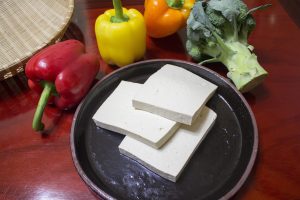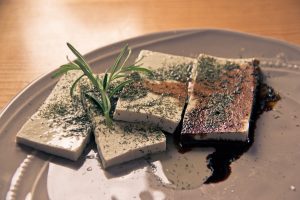
Tofu, also known as bean curd, is a plant-based food made from condensed soy milk. It is made by curdling freshly made soy milk, pressing it into a block, and then cooling it. The curdling process is what gives tofu its signature texture and makes it a great meat substitute. It has a very mild flavor which allows it to absorb the flavors of whatever marinade or seasoning you add to it.
Tofu comes in a variety of textures, ranging from soft and creamy to extra firm. The type of tofu you choose will depend on what dish you are making and the desired texture. Soft or silken tofu is great for smoothies and desserts, while firm or extra firm tofu is better for dishes that require a more substantial texture.
Nutritional Benefits of Tofu
Tofu, a versatile soy-based protein derived from soybeans, is a popular meat alternative that has been consumed in East Asia for centuries. It is low in calories, fat, and carbohydrates, and it is high in protein and dietary fiber. Moreover, it is a rich source of essential minerals, vitamins, and other bioactive compounds, making it an extremely nutritious food.
Tofu is a great source of high quality protein. It provides all essential amino acids the body needs, making it a complete protein. Just one cup of tofu contains 10 grams of protein, which is about 20% of the daily value for protein. Eating tofu can help promote muscle growth and repair, as well as aid in weight loss and maintenance.
Tofu is also packed with essential minerals like manganese, iron, and phosphorus. These minerals play an important role in many bodily functions, from maintaining healthy bones and teeth to producing energy. Tofu is also a good source of calcium, with one cup providing 25% of the daily value for calcium, which is important for healthy bones and teeth.
Tofu is also an excellent source of dietary fiber. Dietary fiber helps to promote digestive health and can help reduce cholesterol levels. One cup of tofu provides 4 grams of dietary fiber, which is 16% of the daily value. Eating a high-fiber diet can help to reduce the risk of heart disease and type 2 diabetes.
Tofu is also a good source of vitamins and other bioactive compounds. It is a great source of vitamin B2, which helps to regulate metabolism and supports healthy skin. Vitamin B2 is also important for the production of red blood cells, which are essential for carrying oxygen throughout the body. Tofu is also a good source of vitamin K, which helps to keep bones strong and healthy. It also contains other bioactive compounds like isoflavones and saponins, which have a range of health benefits, such as reducing inflammation, lowering cholesterol levels, and helping to reduce the risk of cancer.
History of Tofu
Tofu has been a staple food in Asian diets for centuries, although its origins remain a subject of debate. Generally, it is accepted that tofu was first invented in China during the Han dynasty (202 BC to 220 AD). It is believed that tofu was first created when a Chinese cook accidentally mixed a batch of cooked soybeans with nigari, the leftover liquid from making Japanese-style tofu, and the result was a soft and creamy substance known as tofu.
Tofu production quickly spread throughout China, with different variations and recipes. By the 7th century, tofu had become a popular food among the Chinese people. It was an important source of nutrition and provided a cheap protein alternative to meat.
In the 8th century, tofu spread to other parts of Asia, including Japan. In Japan, tofu quickly became an integral part of the diet and a key ingredient in many traditional dishes. Tofu was also used in the preparation of many sauces, condiments, and pickles.
In the 12th century, tofu was introduced to Korea where it quickly became a popular food. Tofu was used in traditional dishes such as kimchi, and it was also used to make desserts and other sweet treats.
Tofu eventually spread to other parts of the world, particularly Southeast Asia. Tofu was not only used as a source of nutrition, but also as a source of protein in diets lacking animal products. In the 19th century, tofu began to be produced in the United States and Europe.
Today, tofu is widely available in grocery stores and restaurants around the world, and is considered a health food. It is made from a combination of soybeans, water, and a coagulant, and can be used in a variety of dishes from savory to sweet. Tofu can be cooked in many different ways and can be used as a meat substitute, a vegan-friendly ingredient, or even as a dessert.
Cooking with Tofu

First and foremost, it’s important to note that tofu is made from soybeans, which are high in protein and calcium. This makes it a great option for those who are looking for a vegetarian or vegan source of protein. It is also very low in calories, so it can be a great addition to any diet.
Once you’ve selected your tofu, you’ll need to prepare it before cooking. The most important step is to press the tofu to remove excess moisture. This can be done by wrapping the tofu in a kitchen towel and placing a heavy object (such as a pot or pan) on top of it. Allow the tofu to sit for at least 30 minutes before proceeding.
Once the tofu is pressed, it’s ready to be cooked. One of the most popular ways to cook tofu is to marinate and then pan-fry it. This is especially popular for making Asian-style dishes. To marinate the tofu, simply mix together a combination of your favorite ingredients such as soy sauce, ginger, garlic, and sesame oil. Let the tofu sit in the marinade for at least an hour before cooking. Once it’s ready, heat some oil in a pan and add the tofu. Cook until it’s golden and crisp on all sides.
Another popular way to cook tofu is to bake it in the oven. This is a great option for those who don’t want to deal with the mess of pan-frying. To bake the tofu, simply marinate it as described above, then spread the cubes on a baking sheet lined with parchment paper. Bake at 400 degrees for about 25 minutes, or until the tofu is golden and crisp.
Tofu can also be used in soups, stir-fries, and salads. To use it in soups, simply cut the tofu into cubes and add them to the stock as it’s simmering. For stir-fries, marinate and pan-fry the tofu as described above, then add the cubes to the stir-fry once the other ingredients are nearly cooked. For salads, cubes of marinated and baked tofu can be added to the mix.
Tofu can also be used in sweet dishes such as desserts and smoothies. To make a creamy tofu-based dessert, blend silken tofu with your favorite sweetener and flavorings such as cocoa powder, peanut butter, vanilla extract, and almond milk. For a delicious smoothie, blend together silken tofu, frozen fruit, honey, and almond milk.
Tofu is a great ingredient to have in your kitchen. It’s incredibly versatile and can be used in a variety of dishes from all over the world. With a bit of experimentation, you can create delicious and healthy meals using tofu. So next time you’re looking for something new to make for dinner, why not try cooking with tofu?
Clinical Trials on Tofu
The first clinical trial to assess the health benefits of tofu was conducted in China in 2002. The study found that people who ate a diet rich in tofu had a lower risk of coronary artery disease (CAD). They also had lower levels of cholesterol, triglycerides, and blood pressure, and a lower body mass index (BMI). The researchers concluded that the high content of isoflavones, the plant-based compounds found in soybeans and tofu, was responsible for these health benefits.
A more recent clinical trial conducted in the United States in 2011 also found that a diet rich in tofu was associated with a decreased risk of coronary artery disease. The study involved over 2000 participants and found that those who ate the most tofu had a lower risk of CAD compared to those who ate the least. The study also found that those who ate more tofu had higher levels of HDL (good) cholesterol and lower levels of LDL (bad) cholesterol.
Another study conducted in China in 2013 found that a diet rich in tofu could reduce the risk of type 2 diabetes. This study involved over 4,000 participants and found that those who ate the most tofu had a lower risk of developing type 2 diabetes compared to those who ate the least. The researchers concluded that the high content of isoflavones in tofu may have contributed to this protective effect.
The most recent clinical trial to assess the health benefits of tofu was conducted in Japan in 2019. This study looked at the effects of eating tofu on the risk of stroke. The researchers found that those who ate the most tofu had a lower risk of stroke compared to those who ate the least. They also found that those who ate the most tofu had lower levels of inflammation markers, suggesting that the isoflavones in tofu may have an anti-inflammatory effect.